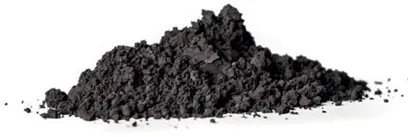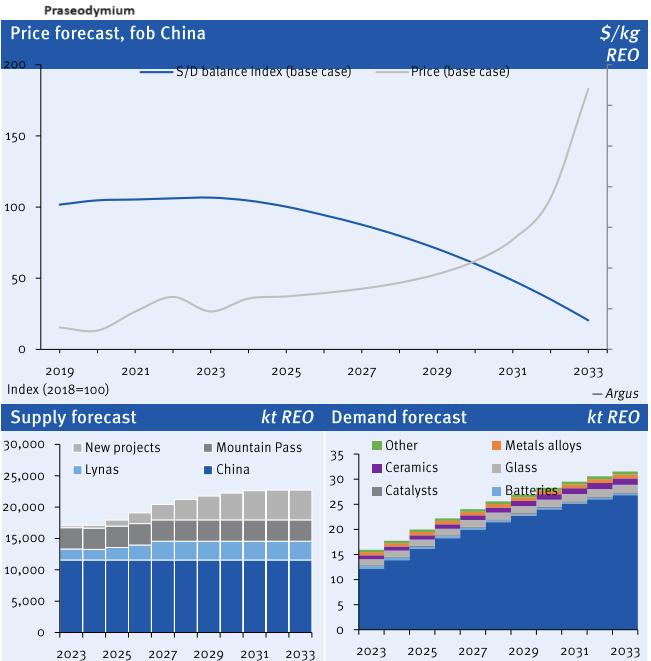Praseodymium Prices
The current price of Praseodymium is $97.40 per kg.
Please note that the price provided here is the retail price for private investors and is aligned with industry retail pricing. For bulk purchases, whether investment or industry, please contact us for a quotation.
Table: Praseodymium Historical Prices and Price Changes
| Date | Praseodymium Price | Change % to Today | Annual Change % |
|---|---|---|---|
| Jul 18 2025 | $97.40 / kg | ||
| Jan 1 2025 | $96.10 / kg | +1.35% | -15.65% |
| Jan 1 2024 | $112.80 / kg | –13.65% | -43.15% |
| Jan 1 2023 | $198.40 / kg | –50.91% | -43.15% |
| Jan 1 2022 | $217.30 / kg | –55.18% | -8.70% |
| Jan 1 2021 | $83.40 / kg | +16.79% | +160.55% |
| Jan 1 2020 | $72.77 / kg | +33.85% | +14.61% |
| Jan 1 2019 | $80.75 / kg | +20.62% | -9.89% |
| Jan 1 2018 | $85.68 / kg | +13.68% | -5.75% |
Praseodymium Historical Price Movement
At today’s price of $97.40 per kg, praseodymium has changed +1.35% since the start of this year and –13.65% since Jan 1st 2024. It is down –55.18% since Jan 2022.
This rare earth has gained +16.79% compared to its price of $83.40 per kg on Jan 1st 2021 and is up +33.85% since Jan 1st 2020. If we go back to Jan 1st 2018, when the cost of a kilogram of praseodymium was $85.68, then the price has increased +13.68%.
Praseodymium is a chemical element belonging to the rare earth group of metals. It has the atomic number 59 and is represented by the symbol Pr on the periodic table. Discovered in 1885 by Carl Auer von Welsbach, praseodymium has a silvery-white color when in its purest form.
To predict where praseodymium prices may head in the future (jump to forecast), it’s important to understand its many applications and who produces it. Let’s dive deeper into this valuable metal and what role it plays globally.
Praseodymium Uses

Praseodymium’s unique properties make it incredibly useful in a variety of applications. It has been used for decades as an alloying agent for softer metals, like aluminum and magnesium, to strengthen them without reducing their flexibility (e.g., to use in aircraft engines). Strong praseodymium-iron-boron magnets are commonly used in smartphones, wind turbines, and electric motors due to their superior strength and lightweight properties.
This rare earth element is used for creating neutron-absorbing control bars in nuclear reactors because of its ability to absorb neutrons. Praseodymium has also proven effective in other areas, such as glass manufacturing, fluorescent & energy-saving lamps, and studio lighting.
Scientists have even found praseodymium to be effective in specific medical treatments as its strongly-magnetic properties are similar to those of iron and can help combat blood disorders that result from iron deficiencies. Praseodymium-177, which emits beta particles, also targets cancerous tissue for destruction.
Other applications include lasers, thanks to this rare earth’s ability to absorb light and fuel cells, where it can be used as an electrode. Lastly, praseodymium plays a role in TV and cellphone color displays due to certain praseodymium compounds’ capability to emit red and green light wavelengths.
In conclusion, praseodymium showcases why it is such a valuable element for modern society with its many uses in various industries.
Where is Praseodymium Produced?
Even though it’s considered a rare earth metal, praseodymium isn’t particularly rare, making up 9.2 mg/kg of the earth’s crust. Mineable praseodymium reserves are found mainly in two areas: China and India. China uses monazite ore sourced from the coastal region of southeastern China, while India uses ion-adsorption clay mines primarily located in the southern province of Karnataka. Praseodymium deposits can also be found in certain parts of Brazil, the United States, Australia, Malaysia, South Africa, and Vietnam.
Praseodymium is extracted through a process known as fractional crystallization. Because China does most of the refining, the US and EU consider this rare earth metal crucial for national and economic security. While China made up 68.57% of global rare earths mine supply in 2023 (source – Statista), they accounted for 85% of the global supply of refined rare earths (according to a study from the Brookings Institute).

What Factors Determine the Price of Praseodymium?
The price of this valuable resource largely depends on the forces of supply and demand.
Praseodymium is a rare earth element with various uses, such as in electric and hybrid cars, wind turbines, and smartphones. An increase in sales for these products would result in greater demand for praseodymium, which would subsequently push up prices.
Keeping tabs on related geopolitical events along with China’s production also has far-reaching implications regarding its availability which could affect pricing at any given time too. Therefore, understanding how market fluctuations work around praseodymium supplies will help us gain insights into where its cost may be headed down the line.
Praseodymium Price Forecast
Praseodymium plays a vital role in many applications in the modern world, from nuclear reactors, lasers, and medical treatments to electric cars, smartphones, and wind turbines.
The demand for most of these applications will continue to grow over the next 30 years, especially as the world goes “green” and aims for carbon neutrality by 2050. Ford and BMW are just two car manufacturers announcing investments totaling over $31 billion in raw materials and infrastructure for building hybrid and electric cars. The adoption of electric vehicles alone will require an additional 200,000 tonnes of rare earths over the next 10 years.
China dominates the supply of praseodymium, accounting for 85% of the refined rare earth elements sold today. They didn’t get to this position by luck. In 1987, then-leader Deng Xiaoping famously said, “the Middle East has oil, China has Rare Earths”. Now in this 21st century, all Western nations and multinationals wait in line until China satisfies its own domestic demand.
And that demand is growing as the goal of the Chinese government is for its domestic consumer economy to equal and then exceed its export economy. China has big plans for electric cars, wind turbines, and solar panels. They’re also introducing new environmental standards for the industry, which will further constrain global supply.
Adding to these pressures, the re-election of Donald Trump has reignited trade tensions between the US and China, further complicating the rare earth supply landscape. China has already imposed complete export bans on gallium and germanium to the US in December 2024, and we cannot ignore the possibility of similar actions targeting rare earth elements like praseodymium. Such a move could exacerbate supply constraints, pushing prices higher and highlighting the strategic significance of these materials for both governments and industries worldwide.
Western nations are aware of this critical dependency, with the US identifying 17 rare earth elements, including praseodymium, as crucial for national and economic security in 2018. Investments in projects to create rare earths mines and processing facilities in Europe and the US have started. However, any of these projects will still take several years. For example, it’ll take 10 to 15 years before any rare earths come to market from Europe’s largest-known deposit of rare earth oxides, estimated at over 1 million tonnes, discovered in Sweden in January 2023. Moreover, this project will likely face significant resistance due to its potentially harmful environmental impact.
China has a 40-year headstart, and while the dependence on them for the raw mined supply of rare earths is expected to fall to 45% from 50–60% today, China’s dominance of the refining stage will remain very robust for many years.
After a 3-digit price hike in 2021 (+161%), praseodymium saw a 55% decrease in value over the past three years. However, the future looks bright, with an ever-increasing demand for praseodymium from multiple industries for the next 20 years and a limited supply for the foreseeable future.
The recent price correction suggests more upside than downside potential in the medium to long term. Market dynamics, especially China’s decisions on export quotas and domestic supply limitations, could trigger notable price surges, making praseodymium a potentially attractive option for savvy investors.
Below are 10-year forecast graphs by Argus Media for Praseodymium’s future price (fob China), demand, and supply.

How to Buy Praseodymium
Hobbyists interested in purchasing praseodymium may easily find it on sites like Amazon, Alibaba, and eBay. However, these sources offer no assurance of purity or liquidity for the buyer other than what another hobbyist is willing to pay.
For higher quality standards and greater certainty when buying this valuable rare earth metal, corporate buyers such as Samsung, Ford, Tesla, and Panasonic purchase through reputable metals dealers who serve as a bridge between high-tech industries seeking raw materials and the producers supplying them. Those that want to benefit from potential future price increases by owning some praseodymium can do so with us, knowing that they’re buying from the only licensed global industry supplier offering investors private access to this exciting asset class.
Praseodymium futures contracts are also traded in the Shanghai Metal Market (SMM).
How to Sell Praseodymium
Rare earths like praseodymium are highly sought-after by industry buyers like General Motors, LG, and Apple. However, they only purchase from reputable suppliers who can provide a full chain of custody, including analysis reports on purity levels plus adequate storage facilities.
Hence, to ensure the fast and safe liquidation of this resource for investors, it’s crucial that they source it from a reputable supplier, like ourselves, in the first place (all our praseodymium is certified min. 99% pure). Otherwise, they can only sell their praseodymium to hobbyists on online marketplaces like eBay or Alibaba.
Only industry metals traders have the bona fides required to sell to industry giants, guaranteeing market price sales.
All prices on this page last updated Jul 18 2025.


